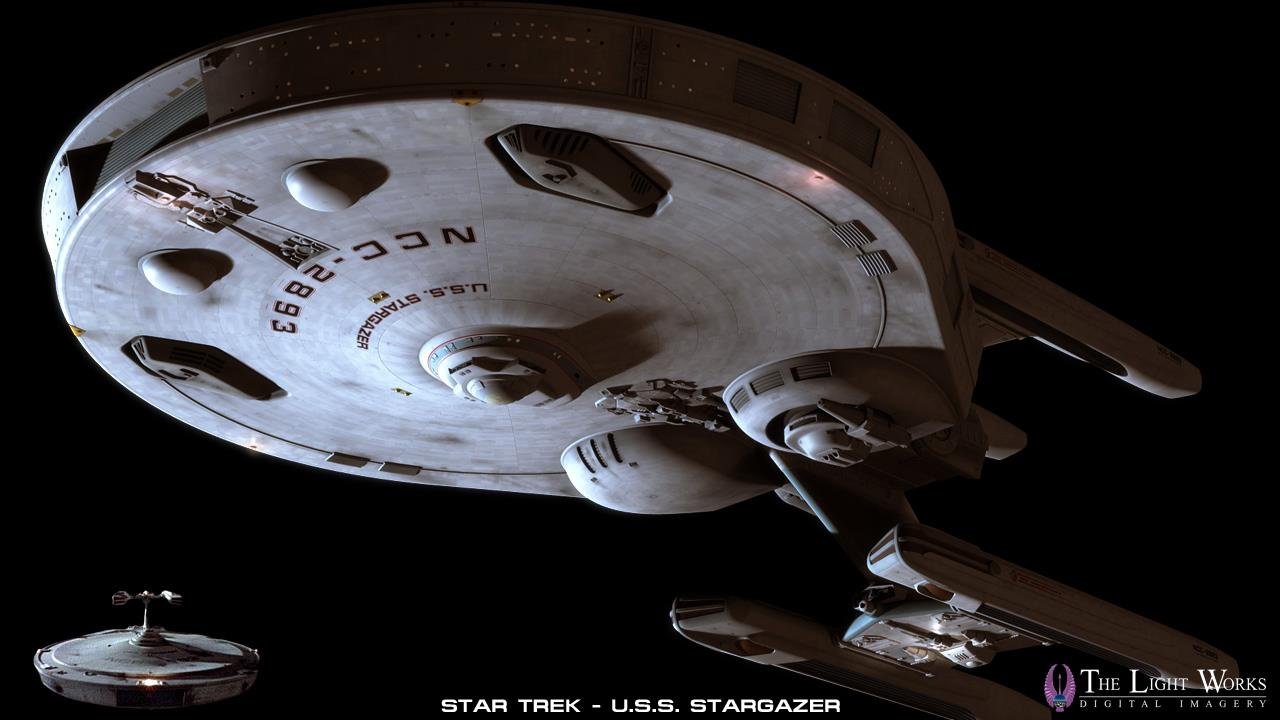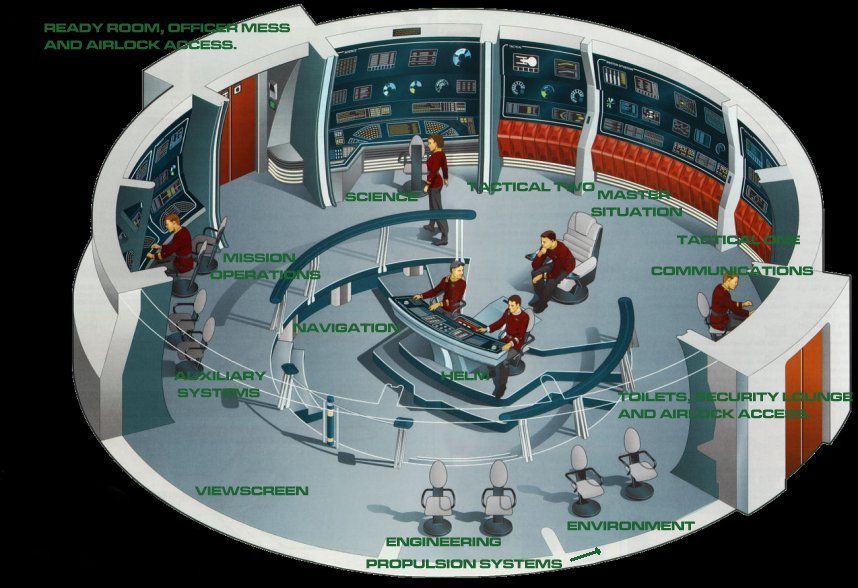

U.S.S. Rattlesnake, Constellation class NCC-16521. Constellation class Rattlesnake is part of Starfleet’s new Sixth Fleet. The Sixth Fleet was formed to administratively control the ‘Southern’ end of Federation space, exploring out toward the rimward frontier. Although probes and individual explorer starships such as the Enterprise have voyaged out this way before, the Rattlesnake is working to expand the Comm-Pic hyper-channel subspace network to bring real-time communications for Federation colonies and starships.
The Rattlesnake is utilising her aft torpedo launcher to deploy the subspace communications relays, which then network with all other relays in range. Captain Miguel Rodriguez is the Commanding Officer with Commander Kristina Mínervudóttir as Communications and Executive Officer. Starbase Dehner is one of the facilities that the Rattlesnake is helping to bring online – a deep space Regula style research station that is within sensor range of the Galactic barrier on the outer rim of the Milky Way. This mission should bring the Starbase online as well as provide real-time communications with the rest of the Federation heartland. Starbase Dehner is named for Dr. Elizabeth Dehner.
A fleet of scientific starships, including Monoceros, Pillinger, Trista and T’lani classes, are en route to Starbase Dehner, supported by a couple of Mughi class auxiliary vessels and a couple of tankers. Once in place this scientific task group will be able to study the barrier and other local phenomena in fine detail as has not been possible before this. A new Excelsior class starship, Discovery, is leading this convoy towards the new Starbase.
U.S.S. Rattlesnake is not alone in exploring the far reaches of the rimward sectors. The starship Investigator also has been sent towards the Galactic barrier and has been sent on ahead of the Rattlesnake. There are six Constellation class starships and a similar number of Constitution class ship with a handful of Excelsior class allocated to the Sixth Fleet. Starbase 44 is the fleet headquarters and has construction and repair facilities capable of dealing with all classes of starship. The Oberth class science and survey vessels are continually being constructed or refitted, crewed and sent out rimward to study planets and phenomena that the probes and explorer type vessels find. Monoceros, Pillinger, Trista and T’lani class starships are also found in abundance in the Sixth Fleet, supporting the scientific and exploration programs in the region.
Shuttlecraft:
1 – Stanley – named for Captain Owen Stanley.
2 – Yule named for Lt C B Yule
3 – Huxley named for the ship’s marine naturalist.
4 – MacGillivray named for John MacGillivray the ship’s botanist.
5 – Brierley named for Oswald Brierley the ship’s artist.
The Sixth Fleet
Based out of Starbase 44 in the rimward end of the UFP. The Regula system (in the Mutara Sector) was chosen for the highly-controversial Genesis project purely on the basis that the system was so remote from the then-frontier of the Federation. In the thirty years since then, Federation colonies have pushed further out into the region. The debris of the Genesis Planet is still off-limits, as is Regula One. Exploration and consolidating space as Federation space has been made possible by the advent of the long-rang speed of the Constellation class.
Often referred to as the ‘Southern Fleet’, the Sixth Fleet, from its geography, is far-removed from the border conflicts of the Klingons, Romulans and Tholians. This is a fleet that deals with unknown, unexplored space and attracts many Starfleet recruits that joined to further this endeavour. There is still a dreadnought, Arkansas, and a carrier, (Pegasus, assigned to this fleet for defensive purposes. With the calming down of activity on the Romulan and Klingon borders, the Federation is now concentrating on Starbase construction and exploration out towards the rim.
Author's Notes:
Rattlesnake comes from HMS Rattlesnake (1822) that was a 28-gun sixth-rate corvette of the Royal Navy that was converted into a survey ship in 1845. Under Captain Owen Stanley the ship went to Australia and New Guinea.
Comm-pic hyperchannel is from Star Trek II and is presumably the long title for subspace communications. It makes sense for a Constellation class starship to do the relay laying as they have the fastest performance over long distances. The use of the Blue Ridge as command ship is a homage to the command ships Blue Ridge and Mount Whitney of the Second and Sixth Fleets of the US Navy. The Rattlesnake will relay with a Mughi class auxiliary to pick up more subspace communication relays to then go and place them.
The Regula One station is depicted on Star Trek: Star Charts and Star Trek Stellar Cartography as being well within Federation space (in 2370s). I’d argue that during the conception and testing phase of the Genesis Project that they chose a location far from prying eyes. Virgin unexplored space makes sense as Stage One was done in a lab but Stage Two was done inside the Regula planetoid. As with Vanguard, having a remote research base is the way to go. Thirty or so years later the Regula system and Mutara sector is now not as remote as it used to be, with planets being colonised in the region.
The Sixth Fleet is similar in nature to the United States Navy Sixth Fleet, which also has Mount Whitney as their command ship. Coronado and Belknap were amongst the previous command ships of this fleet. The USN sixth fleet operates in Europe and Africa with Destroyer Squadron 60 homeported in Gaeta, Italy.
Crew: 535 [Maximum: 600] Officers: 45
N.C.O.'s: 490
Cruising Warp: 6.
Maximum warp: 8.
Height: 86m.
Width: 175m.
Length: 310m.
Phasers: 12 Turrets.
Torpedo Launchers: 3 [2 Foward, 1 Aft].
Torpedo Compliment: 100.
Warp Engines: MARA
Impulse Engines: Standard
Computer System: DCLD - Duotronic Computer Library Database [Author's Note: Later upgraded to LCARS]
Expected Duration: 100 Years
Time Between Resupply: 3 Years
Time Between Refits: 5 Years
Shuttlecraft: 5 [Various types]
Starship primary mission: Planetary and Deep-Space Exploration.
Designation: Heavy Cruiser
Officers: 45
N.C.O.'s: 490
Cruising Warp: 6.
Maximum warp: 8.
Height: 86m.
Width: 175m.
Length: 310m.
Phasers: 12 Turrets.
Torpedo Launchers: 3 [2 Foward, 1 Aft].
Torpedo Compliment: 100.
Warp Engines: MARA
Impulse Engines: Standard
Computer System: DCLD - Duotronic Computer Library Database [Author's Note: Later upgraded to LCARS]
Expected Duration: 100 Years
Time Between Resupply: 3 Years
Time Between Refits: 5 Years
Shuttlecraft: 5 [Various types]
Starship primary mission: Planetary and Deep-Space Exploration.
Designation: Heavy Cruiser
Primary Hull
This consists of 15 decks that can be summarised thus:
1 Main Bridge, Ready Room, Observation Lounge
2 Senior Officers Quarters, Junior Officers Quarters
3 Executive Mess, Junior Officers Quarters, Crew Quarters
4 Crew Quarters, Stellar Cartography, Main Computer
5 Transporter room, Dorsal Phaser Batteries, Aft Crew Lounge, Impulse Reaction System, Torpedo Bay, Main Deflector
6 Cargo, Laboratories
7 Main Engineering, Engineering Computer, Shuttle Control
8 Arboretum
9 Sickbay, Cargo
10 Shuttlebay, Shuttle Storage, Cargo
11 Environmental Systems
12 Ventral Phaser Batteries
13 Turbolift Storage
14 Antimatter Storage, Antimatter Generator
15 Sensor Pallets
 The above artwork is © Star Trek Fact Files. All rights reserved.
The above artwork is © Star Trek Fact Files. All rights reserved.


















